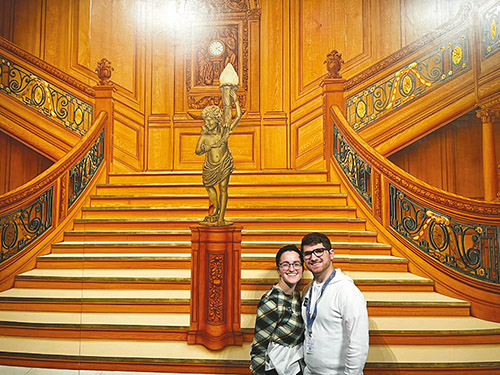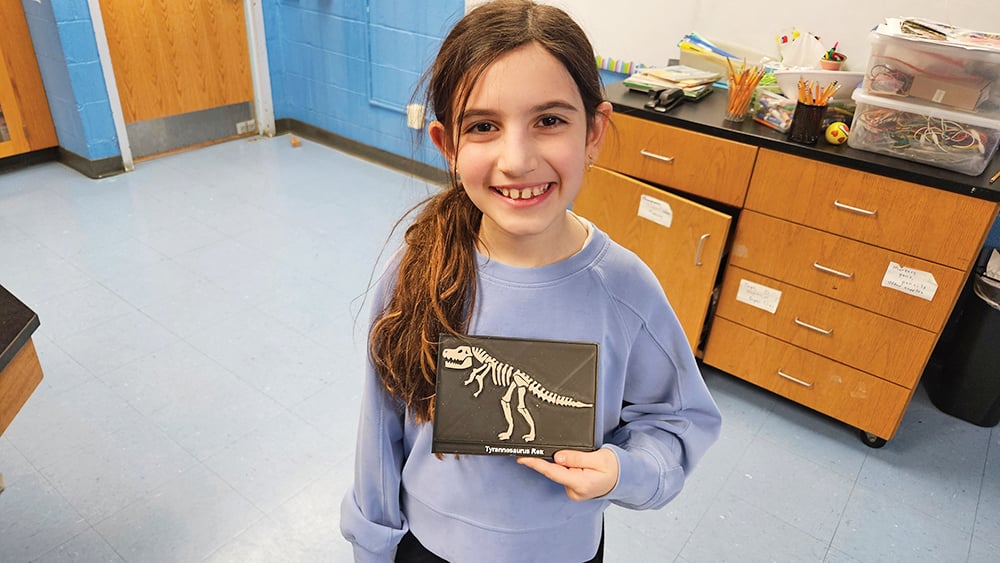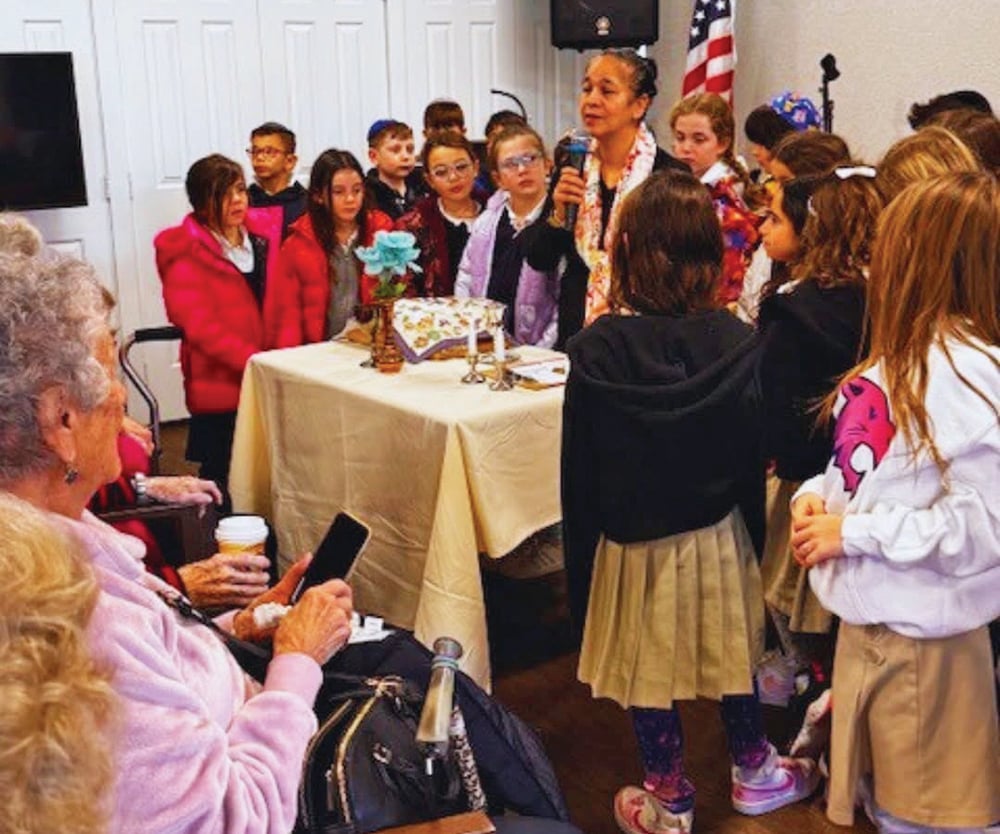
Although the world’s most famous ship, the RMS Titanic, sank in 1912, its story and history remain very much alive to this day. For a limited duration, Titanic: The Exhibition is now open in New York City at Union Square, showcasing artifacts, replicas and photographs, alongside a recorded narrated tour sharing tales of the Titanic’s history. I visited the exhibit with my wife, Ahuva, my brother Gabe, and my aunt Aliza, and we almost felt as though we traveled back in time aboard the famous vessel.
Growing up, Gabe and I have always been fascinated by the tragedy of the Titanic. We used to read voraciously “I Survived the Sinking of the Titanic, 1912” by Lauren Tarshis, which is a historical fiction about a boy surviving the Titanic disaster, and the book “The Titanic Lost … And Found” by Judy Donnelly. As we got older, we watched the blockbuster James Cameron film adaptation, “Titanic” many times. We were allured by the extraordinarily ironic story that despite this ship seemingly being “unsinkable,” on its very first voyage it proved to very much not be the case. It was only appropriate that we secured tickets to the exhibit in New York to experience firsthand and learn more about the gargantuan ship.
The entrance to the exhibit was small, appearing like a regular door for a building. However, its size was deceptive, since it was much larger inside due to the exhibit spanning two levels. After getting our tickets and checking our jackets at the coat room, we headed to the first part of the exhibit, which was a photo opportunity by a Titanic sign. For fun, we reenacted the iconic shot of “I’m the king of the world” from the “Titanic” film. To my surprise, the photographer chuckled, and apparently, we were the first group he had seen to ever do that!

Following that, we were given headphones and a device that had an audio tour for the entire exhibit. Each display of the gallery had a label with a number that corresponded to a number on the audio device. This allowed us to follow along the tour and learn about each section at our own pace since the device had a skip, pause and rewind button. The museum was set up chronologically to make us feel like we were journeying through the catastrophe. The first few rooms told the story about the plans to build the ship. It took two years for 3,000 Harland & Wolff Company employees to build the Titanic. On display were early images of the ships, with details noting how large certain parts were, as well as images of people involved with the building of the ship, including the sponsor, J.P. Morgan.
Next, the tour showed the day the Titanic first set sail on April 10, 1912, from the southeast coast of England. The ship carrying 2,008 passengers and crew first made a stop in France, but the ship was too large to fit in the port, so it had to dock in the bay. On display were original letters from passengers who wrote to their families about their voyage, and beside each letter was a replica of the letter typed up on a screen, making it easier for visitors to read. There were also original postcards with pictures of the Titanic on the front, sent out by passengers.
One of our favorite parts was visiting a replica of one of the first-class hallways. The hallway had fancy red carpeting, dazzling lights, white walls and doors, and golden suite numbers and door handles. We got to walk through the hallway, and the floorboards creaked, making us feel like we were on the ship. Outside the hallways were replica bedrooms aboard the ship, giving us a clear picture of life on the Titanic.
Our tour continued with the ship crashing into an iceberg in the Atlantic Ocean, 500 miles from Nova Scotia, Canada. An animated video showed the process of the ship sinking: It hit the iceberg, the power went out, a large piece of the boat splintered off and dipped down, and the giant smokestacks fell off. The rest of the boat eventually popped out like a seesaw as the bottom half sank until eventually that part slowly sank, too.

While I watched the video play, I heard intense music playing in the background of the recorded tour through my headphones as the guide explained what was occurring and shared interesting facts. We learned that in total, 75% of the third-class passengers died, while only 38% of the first-class passengers died, mostly because the third-class was situated further from the lifeboats. We also found out that in 32-degree weather, the average person could only survive 20 to 25 minutes in the water. I had always thought that most people died from drowning, but I was surprised to hear that 90% of deaths were from hypothermia.
One of the main rescue boats, the Carpathia, was 58 miles away when the Titanic hit the iceberg and was one of the first ships to help. It rescued 712 passengers before sailing to New York, where it docked on April 18, 1912. There was a replica transmission room showing how crew members signaled in Morse code for help.
Near the end of the exhibit, there was footage of the Argo, a deep-sea video camera that found the remains of the Titanic in 1985. From the audio tour, we heard recordings of the marine biology team cheering as the Argo first found the ship. The finale of the exhibit was a list of all the crew and passengers who died in the North Atlantic on April 15, 1912, along with their ages.
After the tour, we visited a gift shop and bought some souvenirs, such as our photo, a mug and a “Teatanic,” a Titanic-themed tea infuser. The gift shop was quaintly designed, reminding me of an old ship. There were also books, cups, shirts, shot glasses, hats, jewelry and chef aprons for sale.

Personally, what I enjoyed the most about the tour was how the audio device told the personal stories of the passengers and crew members and why they were on the ship. This enhanced the overall experience by connecting me with the lives of the people on board, many of whom did not survive. For many people, being on the Titanic was the opportunity of a lifetime, and it made the calamity of what occurred all the more impactful.
There were a lot of cool artifacts that miraculously remained intact and were at the exhibit, such as a second-class dining saloon chair, various serving dishes, a piece of coal from one of the 29 boiler rooms, and one of the few remaining life jackets.
If you are someone who enjoys museums or is interested in the Titanic, I highly recommend checking out Titanic: The Exhibition. You will learn a lot about modern history’s most legendary ship and its calamitous crash. My wife generally does not enjoy museums, but she told me afterward with a glowing smile that she really enjoyed the experience because she learned a lot. She even made some insightful Instagram Reels on our new page “Funzacktivities,” and I highly recommend you give them a view.
I could not possibly cover or describe in detail all that we saw and heard. Titanic: The Exhibition offers so much amazing history and is only open through January 31, so be sure to purchase your boarding tickets soon!

Admission: Standard: $35 per adult; Child:$23; Senior, Student, Military: $27; VIP: $45 per adult (includes fast-track entry to the exhibition, complimentary use of the cloakroom and a souvenir photograph)
Hours: 10 a.m.-7 p.m., early opening at 9 a.m. on Sundays, and late close on Saturdays at 8 p.m.
Location: 526 6th Avenue, New York, NY 10011 (Southeast Corner of W. 14th Street at 6th Avenue)
Unique Feature: Embark on a narrative experience describing the events aboard the famous Titanic

Zachary Greenberg is a health and benefits consultant at Mercer and is the TABC track coach. In 2016, Zachary worked as a farmer on the Yiddish Farm for his senior apprenticeship. Additionally, he recently watched the film “Bullet Train” on Netflix. If you have any recommendations for fun places for Zachary to cover, please email him at [email protected].













